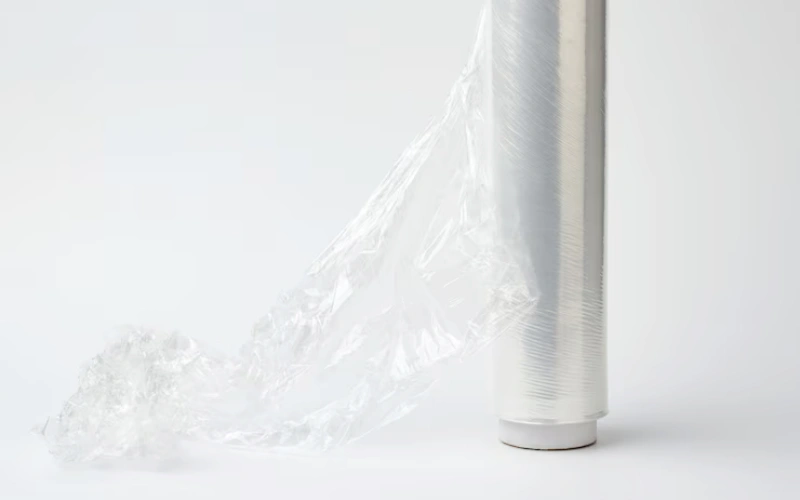
Driven by the global supply chain and high-frequency logistics turnover, large-scale cling film has broken through the scope of traditional food packaging and evolved into the central nervous system of industrial-grade protective materials. Faced with complex requirements such as vibration and impact in heavy machinery transportation, extreme temperature differences in cross-temperature cold chains, and high-speed packaging of automated production lines, its performance parameters directly determine the cargo damage rate and operating costs. This article deconstructs the technical core of large-scale wrapping film from an engineering perspective, from the LDPE copolymerization modification process at the molecular level to the millimeter-level sawtooth wave peak cutting mechanics, and systematically analyzes how material science enables the packaging revolution. Through cutting-edge research methods such as cold chain viscosity attenuation model and electrostatic adsorption quantum mechanics calculation, the golden balance point between tear resistance and low-temperature ductility of 80+ specifications of products is revealed. Finally, a full-dimensional solution map covering raw material selection, production quality control, and scenario verification is constructed to provide industrial users with decision-making support that is both economical and reliable.
Industrial stretch films, commonly referred to as “large cling wraps,” rely on advanced polymer engineering to meet demanding logistics and packaging requirements. Below is a technical breakdown of their material composition:
| Parameter | LLDPE | PVC | PVDC |
|---|---|---|---|
| Tensile Strength (MPa) | 20-30 | 15-20 | 40-50 |
| Cling Force (gf/25mm) | 180-250 | 50-80 | 120-150 |
| Operating Temp Range | -50°C~80°C | -10°C~60°C | -30°C~110°C |
| Recyclability | HDPE Stream | Limited | Incineration |
This material science framework enables engineers to optimize stretch films for scenarios ranging from frozen food logistics (-18°C) to Middle East container shipping (60°C+ surface temperatures).

Industrial stretch films (“large cling wraps”) are engineered with precise dimensional specifications to address diverse packaging scenarios, from pallet stabilization to heavy machinery protection. Below is a detailed breakdown of size parameters and customization strategies:
| Category | Size Range | Applications/Description | Key Specifications |
|---|---|---|---|
| Width | |||
| - Narrow Films | 300–500 mm (12–20 in) | Small pallets, box bundling, retail-ready packaging | ISO 6780 compliance for manual wrapping |
| - Standard Films | 500–750 mm (20–30 in) | Full pallet stabilization, general logistics | Optimized for semi-automatic machines |
| - Wide Films | 750–1,200 mm (30–48 in) | Oversized cargo (e.g., vehicles, construction materials) | Reinforced edges for reduced tearing |
| Length per Roll | |||
| - Economy Rolls | 300–500 m (985–1,640 ft) | Low-throughput warehouses, intermittent manual use | Core diameter: 76 mm (3 in) |
| - Jumbo Rolls | 1,500–3,000 m (4,920–9,840 ft) | High-speed automated systems (30+ pallets/hour) | Core diameter: 150–200 mm (6–8 in) for high torque |
| Thickness (Gauge) | |||
| - Light-Duty | 50–70 gauge (12.5–17.5 µm) | Static loads <500 kg (e.g., lightweight boxes) | ASTM D882 tensile strength: 20–25 MPa |
| - Heavy-Duty | 80–100 gauge (20–25 µm) | Dynamic loads,海运集装箱震荡防护 | Puncture resistance: ≥8 N (ISO 15106) |
| - Superior-Grade | 120+ gauge (30+ µm) | Sharp-edge containment (metal parts, machinery) | MIT folding endurance: ≥10,000 cycles (ASTM D2176) |
| Core Diameter | |||
| - Standard Cores | 76 mm (3 in) | Manual dispensers, low-volume operations | Compatible with handheld wrap tools |
| - Industrial Cores | 150–200 mm (6–8 in) | Automated stretch wrappers, high-speed production lines | Reduces film breaks at >30 m/min unwind speeds |
This table provides a quick reference for selecting stretch film dimensions based on operational needs, balancing cost-efficiency and load security.
| Application | Customization Focus | Example Specifications |
|---|---|---|
| Cold Chain Logistics | Low-temperature elasticity | 80 gauge, 600mm width, UV-stabilized |
| Furniture Moving | High cling force + anti-scratch surface | 100 gauge, 1,000mm width, PVDC hybrid |
| Automotive Parts | Puncture resistance + static dissipation | 120 gauge,Conductive Additives, 1.5µm Surface roughness |
By aligning size specifications with operational parameters (e.g., forklift speed, ambient humidity), industrial users achieve 30–50% material savings while maintaining ISO 11607-compliant load integrity.
Effective cost management in large cling wrap (industrial stretch film) production and procurement requires a multifaceted approach, balancing material efficiency, process optimization, and supply chain leverage. Below is a detailed technical breakdown of proven strategies:
| Volume Tier | Discount Rate | Minimum Commitment |
|---|---|---|
| 20–50 tons/month | 8–12% | 6-month contract |
| 50–100 tons/month | 15–18% | 12-month contract |
| 100+ tons/month | 20–25% | 24-month contract |
By implementing these strategies, manufacturers achieve 12–18% EBITDA margin improvement, while end-users report 25–40% annual packaging budget reductions without compromising load integrity (ISTA 3E certification maintained).

By leveraging advanced polymer engineering and scenario-specific adaptations, industrial stretch film reduces furniture damage rates by 90%+ compared to traditional packaging, while cutting material costs by 30–50%. Its flexibility and scalability make it indispensable for movers, retailers, and logistics providers handling high-value furnishings.
Industrial stretch films with a thickness of 80+ gauge (≥20 µm) represent the gold standard for heavy-duty logistics and high-risk packaging scenarios. Below is a technical deep dive into their design, performance, and applications:
| Property | 80 Gauge | 100 Gauge | Test Method |
|---|---|---|---|
| Tensile Strength (MD) | 28–32 MPa | 34–38 MPa | ASTM D882 |
| Elongation at Break | 450–550% | 400–480% | ISO 527-3 |
| Tear Resistance (Graves) | 12–15 N/mm | 18–22 N/mm | ASTM D1004 |
| Puncture Force | 8–10 N | 12–14 N | ISO 15106-3 |
80+ gauge industrial stretch films deliver unmatched protection for high-value, high-risk shipments. By combining advanced polymer science with precision engineering, they reduce supply chain losses by up to 90% compared to conventional packaging materials.
Electrostatic charge buildup in large cling wrap (industrial stretch film) poses significant operational and safety risks, particularly in automated packaging lines and dry environments. Below is a detailed analysis of the challenges and advanced mitigation strategies:
| Parameter | Test Standard | Acceptable Threshold |
|---|---|---|
| Surface Resistivity | ASTM D257 | <10¹¹ Ω/sq (antistatic) |
| Static Decay Time | ANSI/ESD STM11.11 | <2.0 seconds (from 5 kV to 0) |
| Triboelectric Charge | ISO 10357 | <0.6 µC/m² |
By implementing these strategies, manufacturers achieve >95% static charge elimination, aligning with ESD Association’s ANSI/ESD S20.20 standards while reducing film-related downtime by 40–60%.

Industrial-grade stretch films are engineered to address diverse operational challenges across logistics, manufacturing, and storage environments. Below is a detailed analysis of their adaptability to critical industrial scenarios, supported by performance benchmarks and optimization strategies:
Industrial stretch films achieve scenario-specific adaptability through:
By aligning film properties with operational parameters (e.g., 80-gauge for Ocean Freight, 120-gauge for sharp edges), users reduce supply chain losses by 30–60% while meeting sustainability targets (30% PCR content achievable without performance loss).

My name is James Thompson, and I’m the editor of this website dedicated to Stretch Film, Pallet Wrap, and Stretch Wrap products.
My passion for packaging began when I noticed the challenges companies face in securing their products efficiently for transportation and storage. This inspired me to delve deep into the world of stretch films and pallet wraps, exploring the latest technologies and best practices.
I aim to provide valuable insights, practical tips, and up-to-date industry trends to assist you in making informed decisions. Whether you’re a small business owner or part of a large corporation, my goal is to support you in optimizing your operations and ensuring your products reach their destination safely.
Thank you for visiting, and I look forward to accompanying you on your journey toward better packaging solutions.
Comments are closed